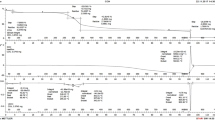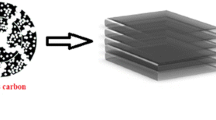Abstract
Oil-palm shell, a biomass waste from the palm oil industry, can be converted into commercially viable activated carbon through pyrolysis, followed by activation. A detailed systematic study of the pyrolysis conditions and initial shell particle size was conducted, and they were found to have significant effects on the pore characteristics of steam-activated carbons. The optimum pyrolysis conditions were (i) pyrolysis temperature of 750 °C, hold time of 2 h, heating rate of 10 °C/min, nitrogen flow rate of 150 cm3/min and particle size range of 2–2.8 mm for pyrolysis in nitrogen flow, and (ii) pyrolysis temperature of 675 °C, hold time of 2 h, heating rate of 10 °C/min and particle size range of 2–2.8 mm for pyrolysis under vacuum. Under nitrogen pyrolysis environment, the best activated carbon yielded the highest BET surface area of 794 m2/g and achieved the largest adsorption capacity of 129 mg of phenol per g of activated carbon. Under vacuum pyrolysis, the best activated carbon yielded the highest BET surface area of 988 m2/g and achieved the largest adsorption capacity of 168 mg of phenol per g of activated carbon which was respectively 24% and 30% greater than those for the activated carbon pyrolysed in nitrogen flow. Of all pyrolysis parameters studied—pyrolysis temperature, hold time, heating rate (low heating rate region), nitrogen flow rate, shell particle size and pyrolysis environment—the pore characteristics of the steam-activated carbons are strongly dependent on the pyrolysis temperature, hold time, pyrolysis environment and initial particle size.















Similar content being viewed by others
References
Guo J, Luo Y, Lua AC, Chi R, Chen Y, Bao X, Xiang S (2007) Adsorption of hydrogen sulphide (H2S) by activated carbons derived from oil-palm shell. Carbon 45:330–336
Guo J, Lua AC (2000) Adsorption of sulfur dioxide onto activated carbons prepared from oil-palm shells impregnated with potassium hydroxide. J Chem Technol Biotechnol 75:971–976
Guo J, Xu WS, Chen YL, Lua AC (2005) Adsorption of NH3 onto activated carbon prepared from palm shells impregnated with H2SO4. J Colloid Interface Sci 281:285–290
Zhao X, Zeng X, Qin Y, Li X, Zhu T, Tang X (2018) An experimental and theoretical study of the adsorption removal of toluene and chlorobenzene on coconut shell derived carbon. Chemosphere 206:285–292
Gonzalez-Garcia P (2018) Activated carbon from lignocellulosics precursors: a review of the synthesis methods, characterization techniques and applications. Renew Sust Energ Rev 82:1393–1414
Pereira MFR, Soares SF, Orfao JJM, Figueiredo JL (2003) Adsorption of dyes on activated carbons: influence of surface chemical groups. Carbon 41:811–821
Lua AC, Jia Q (2009) Adsorption of phenol by oil-palm-shell activated carbons in a fixed bed. Chem Eng J 150:455–461
Balci S, Dogu T, Yucel H (1994) Characterization of activated carbon produced from almond shell and hazelnut shell. J Chem Technol Biotechnol 60:419–426
Laine J, Yunes S (1992) Effect of the preparation method on the pore size distribution of activated carbon from coconut shell. Carbon 30:601–604
Gonzalez JF, Roman S, Encinar JM, Martinez G (2009) Pyrolysis of various biomass residues and char utilization for the production of activated carbons. J Anal Appl Pyrolysis 85:134–141
Uysal T, Duman G, Onal Y, Yasa I, Yanik J (2014) Production of activated carbon and fungicidal oil from peach stone by two-stage process. J Anal Appl Pyrolysis 108:47–55
Gergova K, Petrov N, Eser S (1994) Adsorption properties and microstructure of activated carbons produced from agricultural by-products by steam pyrolysis. Carbon 32:693–702
Rodriguez-Mirasol J, Cordero T, Rodriguez JJ (1993) Preparation and characterization of activated carbons from eucalyptus kraft lignin. Carbon 31:87–95
Lua AC, Yang T (2004) Effects of vacuum pyrolysis conditions on the characteristics of activated carbons derived from pistachio-nut shells. J Colloid Interface Sci 276:364–372
Wu H, Chen R, Du H, Zhang J, Shi L, Qin Y, Yue L, Wang J (2019) Synthesis of activated carbonfrom peanut shell as dye adsorbents for wastewater treatment. Adsorpt Sci Technol 37(1-2):34–48.
Foo KY, Hameed BH (2011) Preparation of activated carbon from date stones by microwave induced chemical activation: application for methylene blue adsorption. Chem Eng J 170:338–341
Lua AC, Guo J (1999) Chars pyrolyzed from oil palm wastes for activated carbon preparation. J Environ Eng 125(1):72–76
Lua AC, Lau FY, Guo J (2006) Influence of pyrolysis conditions on pore development of oil-palm-shell activated carbons. J Anal Appl Pyrolysis 76:96–102
Liu DD, Jia BY, Li S, Dong LJ, Gao JH, Qin YK (2019) Effect pf pyrolysis conditions on the improvement of the physicochemical structure of activated carbon obtained from Jixi bituminous coal. Asia Pac J Chem Eng 14:e2289. https://doi.org/10.1002/apj.2289
Guo J, Lua AC (2001) Kinetic study on pyrolytic process of oil-palm solid waste using two-step consecutive reaction model. Biomass Bioenergy 20:223–233
Acknowledgements
The author would like to thank Dr. Qipeng Jia for his assistance in the experimental work.
Author information
Authors and Affiliations
Corresponding author
Additional information
Publisher’s note
Springer Nature remains neutral with regard to jurisdictional claims in published maps and institutional affiliations.
Rights and permissions
About this article
Cite this article
Lua, A.C. A detailed study of pyrolysis conditions on the production of steam-activated carbon derived from oil-palm shell and its application in phenol adsorption. Biomass Conv. Bioref. 10, 523–533 (2020). https://doi.org/10.1007/s13399-019-00447-9
Received:
Revised:
Accepted:
Published:
Issue Date:
DOI: https://doi.org/10.1007/s13399-019-00447-9




